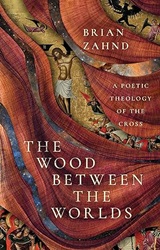A Poetic Theology of the Cross
by Brian Zahnd
InterVarsity Press, 2024. 206 pages.
Review written October 21, 2024, from my own copy, purchased via Amazon.com.
Starred Review
Here’s another book about the theology of the cross. This one, as seen in the title, takes a poetic approach. Here’s how he puts it in the first chapter, as he tells about a walking trip in Spain where he entered every church along the way and paid attention to the crucifixes:
For six weeks I saw different crucifixes every day, and as I walked, I meditated on what it meant that when the Son of God came into the world he was nailed to a tree. I heeded the Spirit’s admonition to resist a quick answer. This is the bane of tidy atonement theories. The idea that we can sum up the meaning of the crucifixion in a sentence or two borders on the blasphemous. Atonement theories have an unfortunate tendency to reduce the crucifixion to a single meaning. This is an enormous mistake. If you’re going to dabble in atonement theories, at least keep it plural. Reducing the cross to a single meaning quarantines the cross so it doesn’t touch too many areas of our lives.
So this book is more of a meditation on the cross than it is an explanation of the cross. There is an inset of color pictures of crucifixes from all over the world and from many different time periods.
Here’s another way he puts that thought:
The meaning of the cross is not singular, but kaleidoscopic. Each turn of a kaleidoscope reveals a new geometric image. This is how we must approach our interpretation of the cross – through the eyepiece of a theological kaleidoscope. That the word kaleidoscope is a Greek word meaning “beautiful form” makes this all the more apropos. I believe it is safe to assume there are an infinite number of ways of viewing the cross of Christ as the beautiful form that saves the world. In this book I seek to share some of the beautiful forms I see as I gaze upon the cross through my theological kaleidoscope.
But one thing you will not find here is any teaching that Jesus saves us from God.
The cross is not what God inflicts in order to forgive; the cross is what God in Christ endures as he forgives. This is an essential and enormous clarification! At the cross the Son does not act as an agent of change upon the Father. Orthodox theology has always insisted that God is not subject to change or mutation. Rather, God is immutable. Thus the cross is not where Jesus changes God but where Jesus reveals God. On Good Friday Jesus does not save us from God; Jesus reveals God as Savior! We don’t have to imagine the Son pacifying an angry Father in order to understand Good Friday as the epicenter of forgiveness.
Instead, Jesus shows us what God is like.
What do I see when I look upon Christ in death with a pierced side? I see that a soldier’s spear has opened a window into the heart of God. As I gaze into the heart of God I discover that there is no wrath, no malice, no threat, no vengeance; only compassion, mercy, and forgiveness. Jesus said, “Out of the abundance of the heart the mouth speaks” (Mt 12:34). Jesus dies, not with a curse upon his lips, but with a plea for pardon. To see Christ upon the cross is to see into the very depths of the heart of God. Where once in our distant pagan past we imagined there lurked monstrous intent threatening harm, we now discover there is only tender compassion. On the cross we encounter a God who would rather die than kill his enemies. When we look through the riven side of Christ into the heart of God, we gaze upon a vast cosmos filled with galaxies of grace.
I like the way he also reaches for poetry, literature, music, and art to help us understand the centrality of the cross – as you can see in the title from C. S. Lewis.
The cross of Christ is the wood between the worlds – the world that was and the world to come.
Or you can see it in the chapter using images from Tolkien’s writings.
Just as Middle-earth could not be saved, only enslaved, by the Ring of Power, so Christianity cannot save the world by political power; it can only be corrupted by it. Jesus Christ crucified is the everlasting indictment on those who forsake the way of the cross to reach for the ring of political power. The power we are promised by our Lord is the power of the Holy Spirit – the power to love, forgive, and heal. If we try to wield the Ring of Power (or Caesar’s sword), it will only corrupt us.
There’s lots more in this book. I think I’m giving up on summarizing it and will be content that the quotations I’ve pulled out will give you an idea of what’s here. I recommend this book as an aid to meditating on the cross of Christ, the wood between the worlds.
Find this review on Sonderbooks at: www.sonderbooks.com/Nonfiction/wood_between_the_worlds.html
Disclosure: I am an Amazon Affiliate, and will earn a small percentage if you order a book on Amazon after clicking through from my site.
Disclaimer: I am a professional librarian, but the views expressed are solely my own, and in no way represent the official views of my employer or of any committee or group of which I am part.
What did you think of this book?
